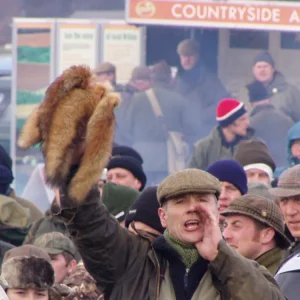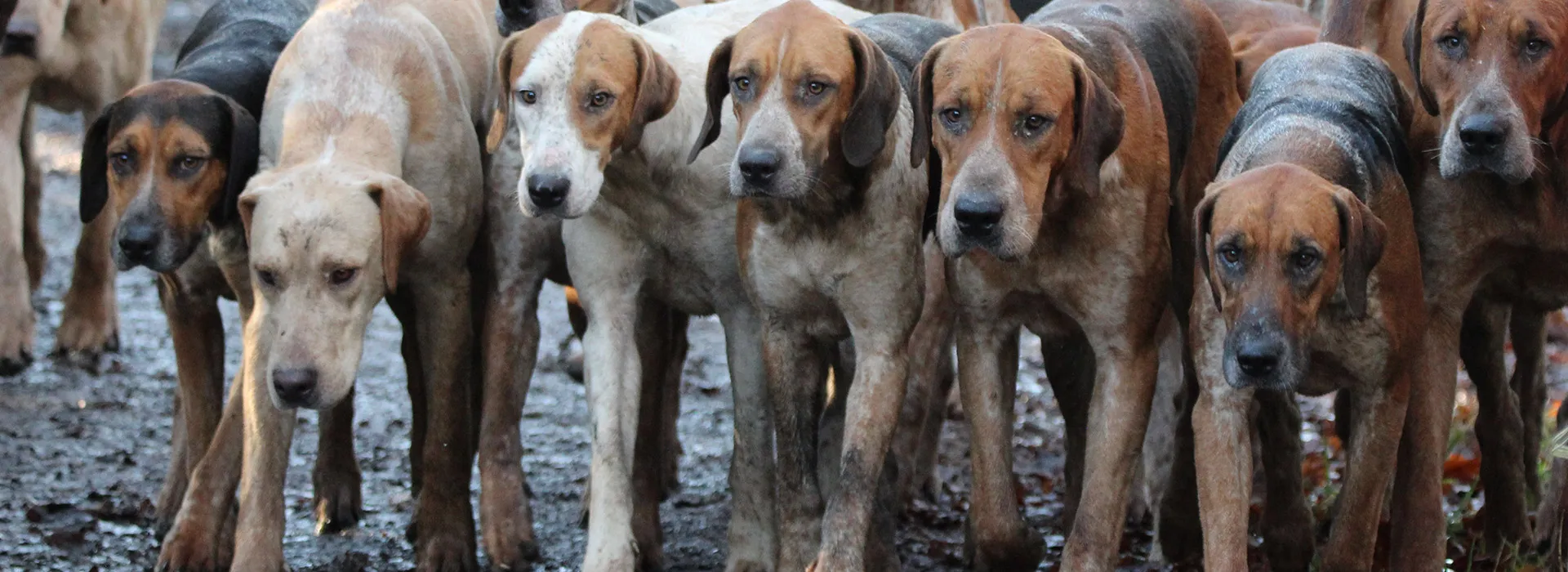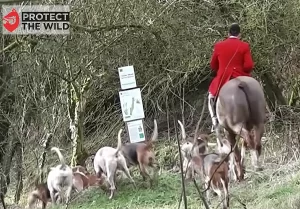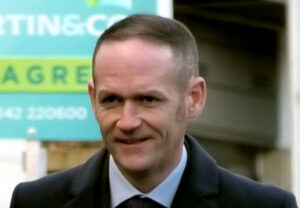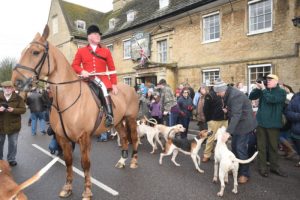The pursuit of stags may soon be outlawed in Britain, but those who still take part are bloodied and unbowed. For the men who monitor their activities, it’s difficult not to feel like the quarry. Rich Cookson joins the chase on Exmoor.
It’s 8.30am on a Monday morning and the sun is still burning off the thin mist that has shrouded Exmoor since dawn. At Perry Farm near Dulverton, a village on the south side of the hills, some 40 stag-hunters have gathered, their red coats startling in the morning sunlight. About 50 hunt supporters have parked their cars along the narrow road and are talking in the sunshine while the hunters make their final preparations. There’s a jovial atmosphere, fostered by the promise of a hot summer day in one of the most picturesque corners of Britain.
But a battered, blue 4×4 vehicle inching through the crowd draws scowls from the supporters and hunters. One supporter eyeballs the driver as he passes; another mouths “wanker” to the passenger.
The master of the hunt emerges from a nearby field on a muscular horse, surrounded by excited hounds, and canters down the road, followed by the other riders. The bystanders spill back into their cars and pursue the red coats down the hill. The 4×4, bristling with radios, binoculars, video cameras, mobile phones and zoom lenses, joins the queue of traffic.
The men inside the vehicle, Kevin Hill and Peter White, aren’t welcome in this part of Exmoor, or indeed in any part of Britain where hunting takes place. They are paid by the International Fund for Animal Welfare (IFAW) to monitor hunts, and have a string of high-profile exposés to their name.
Evidence they have gathered has played a crucial role in the campaign to ban hunting with dogs, allowing MPs and the public to see on film what happens when foxes, deer, hares and mink are hunted. They have brought court cases, helped to shut down two hunts, and embarrassed some of the leading names in hunting.
Last year, for example, they installed hidden cameras in a wood belonging to the Duke of Beaufort, one of the country’s grandest landowners and a friend of the Prince of Wales. Secret filming revealed that animal carcasses were being dumped, in breach of the law, to encourage foxes to feed and breed for the Royal Family’s favourite hunt. The people out hunting with the Devon and Somerset Staghounds today know that if Kevin and Peter capture cruelty on film, it could be all over the national television news by teatime.
A mile or so down the road, they meet up with two campaigners from the League Against Cruel Sports and give them a handheld radio. The LACS Land Rover moves off down the valley, while Kevin and Peter head to a nearby hill with commanding views of the countryside. For more than four hours they watch the hunt, occasionally driving to another position to get a better idea of what’s going on. At this time of year the hunt goes for stags, which tend to be five to six years old. From November to February it hunts hinds (females), and spring stags (younger males, up to three or four years old) in March and April.
The LACS observers make regular contact over the radio, relaying various bugle calls and trying to second-guess the hunters’ next move. All the while, the abuse continues: an off-roader refuses to back into a passing place on a narrow road, forcing them to reverse for several hundred metres. The driver shouts, “Thank you, asshole” as he passes. It’s one of the more polite insults they receive.
By midday the hunters have not found their stag and the hunt is called off. Still mounted on their magnificent horses, the red coats line up to wave goodbye to their supporters. There’s more eyeballing and insults, but Kevin and Peter’s vehicle is the last to leave.
This is an historic moment for stag-hunting. The season opened here on 1 August, and it is probably the last full one the hunters will see. A ban on stag-hunting is likely to come into force in the middle of next season, perhaps in December 2004. The Hunting Bill is due for its second reading in the House of Lords on 16 September, and whatever happens to the proposals to ban fox-hunting (the Lords might force the Commons into some sort of compromise), it is almost certain to make stag-hunting illegal.
The ban will mean that the three registered deer packs in Britain – the Tiverton, the Quantocks and the Devon and Somerset, all in the South-west – will have either to disband or to start draghunting, a form of the sport that involves the riders and hounds following a man-made trail rather than a live animal.
Hunt supporters warn of dire economic and social consequences for Exmoor, but that is hard to believe when you consider the numbers of animals involved. Every year the three hunts kill just 160 deer – about 15 per cent of the numbers that need to be culled to maintain a stable population. The rest are shot by stalkers. “We don’t have a problem with people controlling deer with guns,” Kevin says. “And we don’t have a problem with people dressing up and galloping around the countryside,” Peter adds. “But we are concerned with the animal cruelty.”
Stag-hunting was banned on National Trust and Forestry Commission land in 1997, after a study by one of the UK’s foremost animal behaviour experts, Professor Patrick Bateson, concluded that it was cruel. The Government’s inquiry into hunting, chaired by Lord Burns, reached a clear conclusion on the issue: “Stalking is in principle the better method of culling deer from an animal-welfare perspective. In particular, it obviates the need to chase the deer in the way which occurs in hunting.” Kevin, who provided evidence to Professor Bateson and appeared before Lord Burns, says he had thought that the Labour Government would impose a full ban on hunting with dogs as soon as it came to power. “Maybe we were naive, but after they’d promised it for 18 years in opposition, we really felt they’d do it,” he says.
The ban might be almost certain, but Kevin and Peter have paid a high price for their convictions. Peter says he has lost count of the number of times he’s been assaulted. “I was punched in the head with a knuckle-duster, and have ended up on crutches a couple of times. I’ve been ridden over [by a mounted rider] and driven at by people in cars. I was strangled and had a bone in my neck broken. I’ve also had guns waved at me and, on one occasion, discharged next to my head.”
Kevin has experienced similar violence, including a serious assault that resulted in jail sentences for his attackers. “I’ve also had a dead badger and fox thrown on my lawn. We regularly get the vehicle trashed: windows broken, the windscreen smashed, the tyres slashed. I used to get phone calls in the middle of the night, but they’ve tailed off recently,” he says.
Peter, 34, became interested in hunting in 1985 when, aged 15, he met some hunt saboteurs in the New Forest and went out with them. He was chased and whipped by a hunter and spent two hours hiding in a bush. “I was petrified,” he says, “but the animal cruelty I witnessed that day made me determined to do something about fox-hunting. I immediately started ‘sabbing’ – it was totally non-violent direct action, something I believe in to this day.” After about eight years, he decided to change tactics. “I realised I had nothing to back up what I was saying, so I decided just to stand back and record what was going on.” Friends clubbed together and bought him a video camera. It would be the start of a dedicated passion.
Peter and a friend filmed fox and deer hunts, sometimes getting to the site of kills on foot before the riders had arrived. “Suddenly we could disprove a lot of what the hunters were saying. The hunters would say that the hounds killed foxes with a quick nip to the back of the neck – it was rubbish, and we got plenty of footage proving that foxes were getting disembowelled.”
The filming quickly became an obsession. Peter would do odd jobs to earn money, but this was his main occupation. “I got into a lot of debt, but we were having great successes. We’d been sabbing the New Forest buckhounds for years, but we went out with cameras in 1994 and they disbanded in 1997. We’d got footage of them drowning deer on local TV and in newspapers. We even held a press conference in the House Of Commons.” Peter also infiltrated hunts to get information and film covertly. In 1998, the director of IFAW saw his reports and asked to meet him, and then offered him a job. “Finally, I could let go of all the stress of making ends meet and concentrate on doing what we do.”
Kevin, 53, joined Peter a few weeks later. Kevin describes himself as an “ordinary, normal plumber”, albeit one with a passion for wildlife photography. He had started campaigning when someone invited him to take photographs of the deer on Exmoor in the early 1990s. “I quickly realised what was happening to the deer and started doing voluntary work for LACS. One day I went out with the Devon and Somerset Staghounds and saw a big stag shot in the head right in front of me.
“Two weeks later I saw an exhausted stag get tangled up in brambles. A huntsman came up and shot it in the back of the head. Everyone thought it was dead, but it stood up again. This time they didn’t shoot it, but let it walk up the slope so that it was much nearer a Land Rover they wanted to put it in. Once it was at the top, they pushed it to the ground and shot it. It was one of those shocks that goes right to the core. I freely admit that I was very upset.”
Kevin was offered undercover work with LACS. He managed to pass as a hunt supporter for six months, bringing back information and film. He worked with LACS from 1992 to 1998. “There were internal problems there that I got fed up with, so I left. Pete had already started for IFAW and they took me on. We’ve been campaigning ever since.”
One week later, the pair are out again with the Devon and Somerset Staghounds. It’s a cooler day – about 17C – with a slight wind and the threat of rain.
The hills look glorious, with the heather in full bloom. Kevin and Peter arrive a few minutes after the hunt has set off, but already the atmosphere is electric. “It’s going to go off today, I can feel it,” Peter says. Kevin is squeezing the 4×4 down a tight lane when a red coat on horseback tries to push past them. He raps the roof with his riding crop and berates them for being “bloody ignorant”. Then Peter catches sight of the stag bolting into dense woods at the bottom of a valley. Several hunters on the road spot it as well. “It’s huge,” says one. The hounds stream across the bottom of the valley and on into the woods. The chase is on.
Kevin speeds off up the hill and takes a sharp right. On the road above, there are 30 or more parked cars and perhaps 60 people peering across the valley. Almost as soon as they arrive a holler echoes across the rolling hills, above the yelps of the hounds, meaning that someone’s spotted the stag again. The supporters rush back to their cars. The hunt is moving quickly and frequently changing direction, which is frustrating for the followers.
Suddenly the stag is less than a hundred metres from the side of the road. It’s a magnificent animal, with imposing antlers and a graceful gait. It turns left and runs in front of a car, then plunges down the steep valley. Two horsemen are riding almost alongside it now, and it seems to be tiring. The hounds race down behind it, out of view.
At the top of the valley, supporters’ cars stretch down the road; maybe 60 cars and 120 or so spectators. Next to Kevin and Peter’s vehicle there are two women with shocking white hair, who must be in their seventies. A Land Rover passes with a tiny baby in the front seat. The hunt is now on private land, so Kevin and Peter have to hold back – they could face prosecution for trespassing here. An uneasy silence descends on the hillside, and after 15 minutes or so, one of the riders calls for a quad bike to carry the carcass up from the valley floor. The stag is dead. Kevin looks upset, Peter angry.
The photographer and I make our way over to where about 40 hunters and supporters have surrounded the dead animal. It’s huge, lying on its right side with its tongue lolling out. One of the hunters takes out a knife and cuts down the hide on the stag’s front leg. He hacks off all four hoofs and hands them to a bystander. Next he slips his knife into the stag’s belly and splits it open. There’s surprisingly little smell. He reaches inside the animal and pulls out the innards. A pale white sack (the bladder?) spills a yellow liquid over the guts.
Then he finds the kidneys – each about the size of a large orange – and passes them to another man, who nods in thanks. His arms are now covered in blood above the elbow. Mobiles are ringing and glances are shot our way. The man locates the liver and cuts it away. He sets it on top of the carcass and starts to slice it into thick steaks, which he hands out, specifying who each one is for. Nearby there are four children with flapping white plastic bags, presumably waiting for some of the meat. At this point we are told that we are on private land and asked to leave.
Back at their 4×4, Kevin and Peter are sombre. “I get completely and utterly frustrated on days like this,” Peter says. Kevin agrees: “I always go through a quiet period after a kill. I’ve seen it hundreds of times, but it always gets to me.”
Tomorrow they’ll be out again, installing hidden cameras in a wood they are targeting. Later in the week they’ll do another stag-hunt. As they leave, they pass a hunter stabling his horse. He yells at them and sticks his thumb up, grinning. Minutes later some supporters jeer on the side of the road. One of them throws something at the vehicle.
Hunt Details:
Devon and Somerset Staghounds
Source: The Independant


